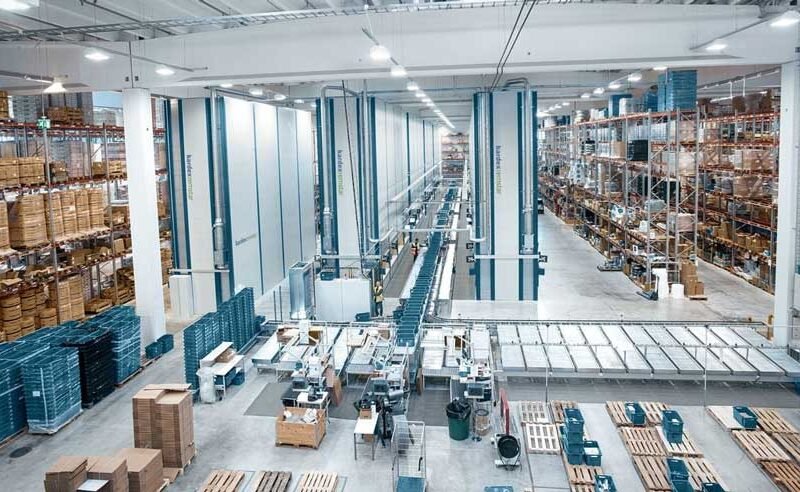Are you trying to figure out how to squeeze more efficiency out of your storage?
Should you go with an automated storage and retrieval system (AS/RS), or stick with traditional racking?
Worry not, you came to the right place. In this article, we will compare the two warehouse approaches, so by the time you finish reading it, you’ll know exactly which side to pick for maximal storage efficiency.
What Are Automated Storage Systems and Traditional Racking?
Before we get on to the comparison, let’s see what exactly automated storage systems and traditional racking are.
Traditional Racking Systems
Traditional racking is like a simple storage room with metal shelves stacked high. Workers are the ones who navigate these shelves, using forklifts or their hands to grab the items.
They include the following layouts:
- Selective pallet racking:It’s made up of upright frames and horizontal beams that hold pallets in single rows.
- Double deep pallet racking:This system stacks pallets two rows deep instead of one.
- Shuttle racks:Instead of separate aisles between each rack, pallets are stored one behind the other.
- Multi-tier longspan shelving:This system uses lightweight shelving units built vertically with walkways or stairs between levels.
Automated Storage and Retrieval Systems (AS/RS)
AS/RS setups use machines (like stacker cranes, conveyors, and robotic shuttles) to store and retrieve items automatically.
They’re often managed with advanced software like WMS (Warehouse Management Systems), WCS (Warehouse Control Systems), and PLCs (Programmable Logic Controllers).
It kind of resembles a Sci-Fi movie: you click a button, and a robot zips down an aisle, plucks the right item from its shelf, and delivers it to your picking station.
Round One: Cost and Investment
Initial investment plays a big role in deciding which option is right for you, so let’s get that out of the way!
Traditional Racking: The Budget-Friendly Choice (Upfront)
If you’re just getting started or you’re a small to medium-sized business, traditional racking systems are easier on your wallet.
They’re straightforward to install, easy to expand over time, and don’t require high-tech infrastructure.
On the plus side, they come with a lower initial cost, allowing you to gradually scale as needed without the need for a dedicated tech team.
However, there are some downsides. Over time, labor costs can remain high, and as your operations become more complex.
The risk of human error also increases as your business grows.
AS/RS: Big Spend, Big Gains
AS/RS systems do require a hefty initial investment. We’re talking cranes, conveyors, control software, and structural redesigns in many cases.
Still, the money spent upfront can quickly pay off by cutting down on labor costs, speeding up operations, and optimizing storage space.
If your warehouse operates around the clock or handles large volumes of orders, the return on investment (ROI) can come faster than expected.
On the downside, the high initial cost, specialized installation needs, and the lack of flexibility once set up can be challenging for some businesses.
Round Two: Space and Storage Optimization
When it comes to warehouses, maximizing space is key, especially since real estate costs are only going up.
Traditional Racking: Some Space Wasted on Aisles
Traditional systems require wide aisles for forklifts and access, which means a good chunk of your floor plan is just, well… air.
General industry benchmarks for traditional racking systems and their configurations suggest that:
- Selective rackinguses about 40% of space for storage, 60% for access.
- Double-deep racksdo slightly better with 60% storage and 40% access.
- Drive-in systemsand shuttle racks use around 70% storage just for access.
No matter how clever your layout is, humans (and their forklifts) still need room to move.
AS/RS: Sky’s the Limit
Automated systems, like Modula modern storage solutions, are designed to take advantage of vertical space. You can think of them as skyscrapers for your inventory.
They’re compact, often built as rack-supported buildings, and can operate in cold storage environments where human access is limited.
With AS/RS, you get:
- More products in less space
- Less storage room wasted on access
- Efficient use of vertical real estate
Simply put, AS/RS can help you make the most of every square foot of your warehouse.
Round Three: Labor and Efficiency
Here’s where the gap really widens.
Traditional Racking: Still Needs a Human Touch
Even with barcodes, scanners, and WMS software, traditional setups depend on people to walk or drive around pulling orders.
That means:
- Slower pick times
- Higher chance of errors
- Fatigue, turnover, and training costs
AS/RS: Humans, Upgraded
With automation, machines do the heavy lifting.
This means:
- Faster order picking
- Fewer errors
- Predictable labor costs
Round Four: Flexibility and Scalability
Let’s talk about the future of your warehouse.
Traditional Racking: Adaptable, but Manual
Should you need to add more racks or rearrange layouts, traditional systems let you do that without calling in an engineering team. You can tweak and grow as your business evolves.
But there’s a ceiling, as you can only scale so much before labor costs and space limitations start to hurt.
AS/RS: Scale Easily
Once you’ve got the infrastructure, scaling is as simple as adding modules or extending rack-supported buildings.
Need to triple your storage? You might not even need more land.
But flexibility is limited once installed. Once you’ve set up an automated system, making changes to how things flow can be tricky.
Unlike traditional racking systems, which you can easily modify or reorganize, automation requires more effort and cost to alter.
If you want to change the layout or adjust the system for different types of products, you’ll need to invest time, money, and often specialized expertise to make those changes happen.
Round Five: Accuracy and Visibility
Nobody likes lost inventory or picking the wrong item.
Traditional Racking: Better with WMS, But Not Perfect
Using barcode scanners and warehouse management software can certainly reduce errors. But you’re still counting on human accuracy.
Upside:
- Tech can boost accuracy
- Affordable tools like RFID and barcoding are widely available
Downside:
- Errors still creep in
- Tracking becomes harder as stock-keeping unit (SKU) volume increases
AS/RS: Accuracy is Kind of Its Thing
With AS/RS, every move is tracked and controlled by software. It knows exactly where every item is, and it picks with precision.
Benefits:
- Real-time inventory updates
- No mispicks
- High reliability in high-volume environments
If accuracy is mission-critical for your business, automation wins by a landslide.
So… Which Should You Choose?
If you’re a growing business with a limited budget, and you want to improve step-by-step, traditional racking with digital tools (like WMS and barcoding) is a smart, flexible choice.
If you’re running a large-scale operation, dealing with tight space, labor shortages, or high order volume, and you’re ready to make a long-term investment, AS/RS will pay you back in no time.
Either way, you’ll want to think about:
- Your current volume
- Future growth plans
- Space constraints
- Budget
- Labor availability and cost










